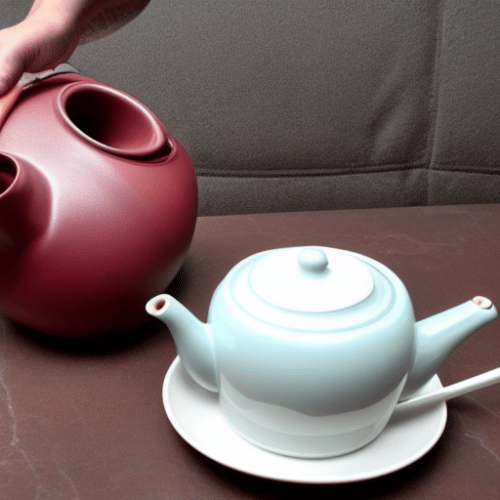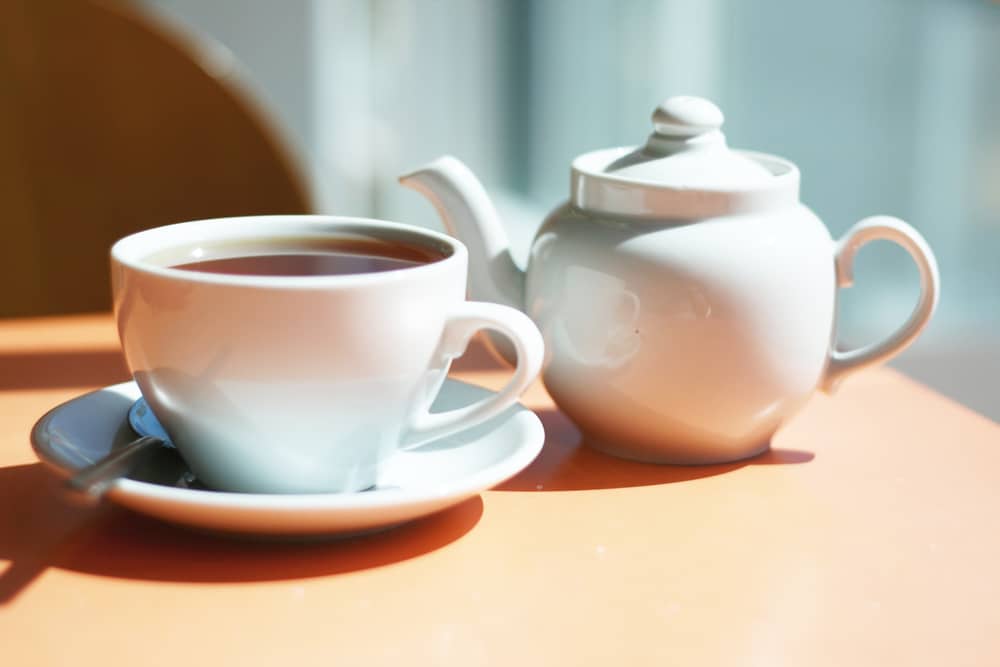Last Updated on
A good teapot is an elegant and beautiful accessory in any kitchen or home. However, the more you use your teapot, the more likely it is to fall victim to stains, discolouration, and other issues. Teapots are durable products capable of withstanding regular exposure to boiling water. However, if you don’t thoroughly clean your pot, you can discover that it loses some of its attractiveness.
Learning how to clean teapots effectively ensures you can enjoy the benefits of your teapot for as long as possible without stressing about the stains left behind by tea leaves.
What’s the Best Way to Clean a Teapot?
The right strategy for cleaning your teapot will often depend on what kind of pot you have. For instance, if you have a metal teapot, boiling some water with some lemons would usually be the finest solution to remove the stains. Alternatively, if you’re cleaning a porcelain teapot, you might prefer to use denture cleaning tablets or even hair dye-developing cream to get the best results.
The most important rule to remember when cleaning your teapots is that washing these products with harsh chemicals is never a good idea. Not only will a strong chemical bleach away the design on your teapot or China while cleaning, but it can also linger in the porcelain or metal.
When you scrub your teapot with chemicals, you run the risk of having an odd taste in the product for years to come.
How to Naturally Clean Your Teapot
Generally, the best way to scrub and clean a teapot will be to use a natural mixture of ingredients like white vinegar and baking soda. If your teapot is a little dirty and you want to get rid of some simple tea stains, all you need is a cup of white vinegar, four tablespoons of baking soda, and some boiling water. Mix your solution in a bucket or pot that’s large enough to hold your teapot.
Leave the teapot for an overnight soak in the white vinegar solution, and then rinse it in the morning with plenty of warm water. You can use a bottle brush or a soft toothbrush to clean the teapot if any remaining stains are left over gently.
If your teapot is dirty, it’s best to immerse your teapot in a large pot of boiling water with lots of vinegar. You can use this method by filling a large pot on the stove with half-full water. Bring this to just under a full boil, then turn down the heat. Once the heat is off, fill about a quarter of the remaining pot with vinegar.
Place your teapot in the pot and leave it to soak overnight. Once again, if you see any marks remaining after you leave your teapot to soak overnight, use a small brush or cloth to scrub the stains carefully. Rinse away any leftover vinegar before you use the pot again.
Other Ways to Clean Your Teapot
Usually, leaving your teapot to soak in a natural solution of warm water and vinegar overnight should be enough to get rid of a build-up of stains caused by tea leaves and boiling water. However, if you can still see evidence of your tea after regular scrubbing, you can try some other methods. For instance:
• Denture tablets are a good way to carefully remove some of the extra gunk off the porcelain of your teapot. If you have a porcelain teapot, place it in a bucket of water with one or two denture tablets and leave it to soak overnight. This should act as an excellent cleaning agent, particularly if you’re trying to get China teapots white again.
• Use developer cream. Cleaning your teapots with the developer cream you get in a packet of hair dye might seem odd, but it’s great for a successful wash. Place your teapot in a large container and fill it to around halfway with hot water. Pour in the developer liquid, and make sure the teapot is fully submerged in the water. Leave the container for about two days before removing your clean teapot. After this long soak, make sure you scrub and rinse the teapot correctly to finish the wash.
• Use lemon juice: Lemon juice is an excellent tool for getting rid of stains on a metal teapot. All you need to do is place your teapot in a pot and fill it with boiling water. Add plenty of lemon juice and slices of lemon, too, if you have any to add to the cleaning power.
Leave the pot to soak overnight, remembering to turn off the heat once you’ve finished boiling your hot water. In the morning, rinse the teapot with hot water. You can also use baking soda to scrub any lasting stains that the soak and hot water haven’t removed.
• Try cream of tartar: To wash your metal teapot with cream of tartar, start by washing the whole teapot with dish soap and water. This should remove any remaining debris from the teapot. Ensure that you use a soft brush if you’re going to scrub metal teapots.
Otherwise, you can scratch the surface when trying to remove the stain. Fill a large pot with water, then add a couple of cups of cream of tartar to the mix. Boil the hot water on the stove with the teapots inside. Turn the heat off and soak overnight if necessary. In the morning, rinse the teapot.
How to Effectively Clean a Tea Pot

The tips above for cleaning a ceramic or porcelain teapot will also work well if you’re looking for a way to wash your teacups or a mug too. Follow the same instructions with any porcelain cup; wash these items with dishwashing soap first, and maybe a little baking soda to remove difficult stains. Remember, in most situations, placing your teapot in a pot of your chosen solution to soak overnight with any cup or mug you want to preserve should do the trick.
Never leave the heat on overnight, and make sure you pour all the mixture away before you start to wipe and rinse your teapot. It may take a little while of extra cleaning before you are ready to towel your teapot off and use it again, particularly if you’ve been using products like white vinegar, which can sometimes leave a smell behind when you’re done cleaning a teapot naturally.
Always check that any soap, baking soda and vinegar paste, cream of tartar paste and other substances are fully removed from the surface and inside of your teapot before you use it. Rinse the lid, too, if you left it on when washing the teapot. You can use a soft sponge to rinse the item thoroughly. If you notice any remaining stains, try a paste made with baking soda and a small amount of water to remove the leftover colour on cups and porcelain.
No More Stains
Above is everything that you need to know about cleaning your teapot. Remember, the more thoroughly you wash your teapot after you’ve had your tea, the less you’ll need to invest in long teapot-cleaning rituals. You can save yourself a lot of time and baking soda with regular teapot cleaning.
What cleaning method works for you?
Rebekah is a writer who loves to explore new products and find hacks that make life easier. She has a knack for all things home improvement, health and fitness. So you’ll often find her on Pinterest or browsing Houzz for ideas.
She’s always looking for the next thing to fix up around the house or what gadget might be just right for her lifestyle. Rebekah enjoys exploring new recipes, taking care of her family, and making sure she stays healthy with regular workouts at the gym.



